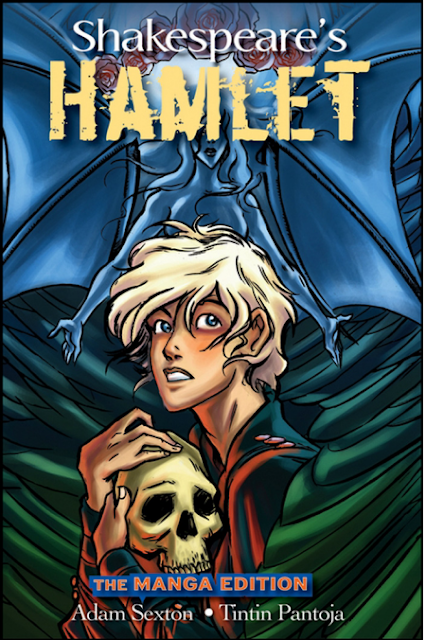Book Name
Hamlet The Manga Edition By Shakespeare's
Author: 1.Shakespeare's 2. Adam Sexton 3. Tintin Pantoja
Book Publishers Wiley Publishing, Inc. Hoboken, New Jersey
Publish Date: 11-02 2008
Language. English
Category English Novel
Book Code 243
Pages 193
Rs 800
Book Quality Black Paper
Whatsapp +92312-9775152
About
The sudden death of the king, later revealed to be murder. The queen’s all-too-sudden remarriage to the king’s brother, the murderer. The grieving, suspicious Prince Hamlet. Supernatural visitations. Plots, leaks, and counterplots. Poisoned wine. A rigged sword fight. Revenge.
With a four-page introduction and an abridged text that remains true to Shakespeare’s wording, setting, and time, this fast-paced, graphic manga edition gets you caught up in the conflicts and passions that make this one of Shakespeare’s most beloved tragedies.
___________________________________________________________________________
Adam Sexton
Adam Sexton is the author of Master Class in Fiction Writing and
the editor of the anthologies Love Stories, Rap on Rap, and
Desperately Seeking Madonna. He has written on art and entertain-
ment for The New York Times and The Village Voice, and he teaches
fiction writing and literature at New York University and criti-
cal reading and writing at Parsons School of Design. A graduate
of Columbia University and the University of Pennsylvania, he
lives in Brooklyn with his wife and son.
___________________________________________________________________________
Tintin Pantoja
Tintin Pantoja is a graphic artist dividing her time between
Indonesia and Manila. She graduated from the School of Visual
Arts in New York in 2006, having arrived in New York—her
first time in America—a month before the World Trade Center
attacks in 2001. She is now working on several illustrated proj-
ects. Tintin’s work can be viewed on her
___________________________________________________________________________
Four hundred years after the writing of William Shakespeare’s
plays, it is clear that they are timeless. This is due in part to their
infinite adaptability. The plays have been translated into dozens
of languages and performed all over the world. Famously cre-
ative stage productions have included a version of Julius Caesar
set in Fascist Europe during the 1930s and a so-called “voodoo
Macbeth.” Nor have gender and age proved barriers to casting
Shakespeare’s characters. The role of Hamlet is occasionally
played by a woman—an appropriate reversal, considering that
boys acted all the female roles in Shakespeare’s day—while the
teenaged Romeo and Juliet have been portrayed by couples in
their forties and fifties.
It is common knowledge that the plays of Shakespeare
transfer especially well to the movie screen. Such has been the
case since Thomas Edison made one of the first sound films ever
using a scene from As You Like It. Recent cinema standouts
include William Shakespeare’s Romeo + Juliet, directed by Baz
Luhrmann, and Michael Almereyda’s Hamlet. Both take place in
the present day or near future: Leonardo DiCaprio’s Romeo
wears a Hawaiian shirt—and Julia Stiles’ Ophelia wears a wire,
so Claudius and Polonius can eavesdrop on her conversation
with Hamlet. Otherwise, these adaptations remain surprisingly
faithful to Shakespeare’s texts. And both hit the audience as
hard as conventional stage productions in which the actors are
1outfitted with doublets and hose, crossed swords, and what
Hamlet calls “a bare bodkin”—his unsheathed dagger (replaced
in Almereyda’s movie by a gun).
Shakespeare’s plays have been set to music as well, in
operas and ballets by composers such as Verdi, Tchaikovsky,
and Prokofiev. The early comedy Two Gentlemen of Verona was
adapted for Broadway by the composer of Hair, and it won the
Tony award for Best Musical the same year that Grease was
nominated. In the words of theater critic Jan Kott, Shakespeare
is indeed “our contemporary.”
In short, though some consider the plays of William
Shakespeare to be sacrosanct, they have been cut, expanded (it
was common in the Victorian era to add songs and even happy
endings to the tragedies), and adapted to multiple media, emerg-
ing none the worse for wear. Although we cannot be sure of this,
it seems likely that the writer, who was a popular artist and a
savvy businessman as well as an incomparable poet, would
approve.
The graphic novels known as manga (Japanese for “whimsi-
cal pictures”) are a natural medium for Shakespeare’s work.
Like his tragedies, comedies, histories, and romances, which are
thrillingly dynamic if properly staged, manga are of course
visual. In fact, a manga is potentially more visual than a stage
production of one of the plays of Shakespeare. Unbound by the
physical realities of the theater, the graphic novel can depict any
situation, no matter how fantastical or violent, that its creators
are able to pencil, ink, and shade.
Take Romeo and Juliet’s famous Queen Mab speech. Even the
most creative stage director cannot faithfully present the minus-
cule fairy described by Mercutio. Manga artists can. The same is
true of the drowning of Ophelia in Hamlet. It is precisely because
these vignettes are unstageable that Shakespeare has his charac-
ters describe Queen Mab and the death of Ophelia in such great
detail—they must help us imagine them. In its unlimited ability












No comments:
Post a Comment